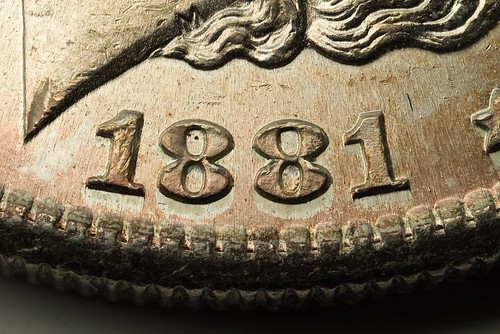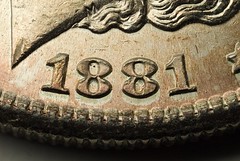
PREV ARTICLE
NEXT ARTICLE
FULL ISSUE
PREV FULL ISSUE
MORE ON THAT COIN TONING EFFECT: NEGATIVE SHADOW AND SURFACE DISPLACEMENT Last week Steve Huber submitted a question about an interesting toning effect often seen on coins. Not surprisingly, some E-Sylum readers have a lot to tell us about it. -Editor  Pete Smith writes: I was interested in the question about differential toning. I have wondered about this for years. In October of 1996 I attended a three day ANA course on grading and counterfeit detection. Part of one session was on toned dollars and presented by Mark Mauer. It was here that I first became aware of the toning effect seen with untoned silver outside of edge lettering. Since then I have asked several authorities for an explanation but have not received what I consider a believable explanation. First let me describe what I believe is accepted by the experts. When a coin is struck, the metal flows outward. The sharp edge of lettering in the die acts as a dam that blocks metal flow. Surface metal fills the void in the lettering and subsurface metal is forced to the surface outside the lettering. What then causes differential toning is the topic of disagreement. At first I thought that planchets were coated with a thin firm of oil, grease or wax that reacted with sulfur dioxide in the air to deposit silver sulfide on the coins. I never found a chemical explanation to make this work. Silver bars, strips and blanks became tarnished as they were processed and annealed. At various stages they were cleaned with dilute sulfuric acid. In the right concentration this could dissolve copper. One theory is that copper was removed from the outer surface of the blank leaving almost pure silver. After striking, most of the surface was pure silver with some areas of 90% silver forced from the interior. The areas with higher concentration of silver toned faster than the areas with higher concentration of copper. There are many other factors that explain why some Morgan dollars show rainbow toning, some show untoned areas outside letters and stars, and some have no toning or very light uniform toning. I have seen the same general effect on some Conder tokens. If my explanation is correct for Morgan Dollars, it does nothing to explain similar effects on copper coins. I am not an expert and have not heard a satisfactory explanation from an expert. I hope some other E-Sylum reader can come up with an explanation we will all accept. Dick Johnson writes: There is a name for the unusual toning that was the subject of the enquiry by Steve Huber in last week's E-Sylum. That name is negative shadow. It is well known to medal collectors because that phenomenon is prevalent on medals struck in tin and white metal. It is caused by stress, tin and cold temperature. It is a form of surface displacement and is created at the instant of striking. It is not metal flowing into, then out of die cavities, as the two numismatists theorized. Surface metal flows toward the deepest die cavities. Since lettering, figures and stars near the border or rim are deep cavities, adjacent surface metal flows into these die cavities from metal near the rim. (The collar has nothing to do with it, as mentioned, this occurs on pieces struck with open face dies where no collar is present.) The area with the unusual toning is in effect, flow marks, caused by the stress of the metal forced into nearby die cavities. All surface displacement occurs from the rim towards the center. Thus flow marks point to the center of the struck piece. Tin and tin alloys have this very unusual property which displays the shadow effect. Tin does not work harden like other coinage metals. Instead it exhibits this condition in its flow marks. This shadow effect is not present immediately after the piece is struck. Freshly struck tin appears bright over the entire struck piece. In time (say two years) tin surfaces will begin to darken from cold exposure -- this is a form of toning but is not called "toning" for tin and white metal. Instead it is called darkening on these metal surfaces. The dark areas on the surface piece which have darkened is a natural phenomenon. This dark area is in contrast to the flow marks caused by the surface displacement which remain bright on the same piece. I have seen two-hundred-year-old medals struck in white metal which still have bright negative shadows! It is assumed this condition is now permanent and will exist forever! The dark toning on white metal is a mild form of tin pest and is a result of the piece exposed to a cold temperature! Tin is unstable below 18 degrees centigrade (64 degrees Fahrenheit). Tin does not rust due to moist air (as does iron) but only by prolonged exposure to temperatures below 18 degrees C. The disease, also call tin plaque, forms a discoloration -- darkening on the struck surface -- then in time forms a gray powdery surface corrosion. Chemically the somewhat unstable metallic tin (beta-tin) changes to the stable powdery form (alpha-tin). Why some silver coins display negative shadow and others do not, I don't know for sure, but I surmise there is some tin in the composition of the struck pieces that do exhibit negative shadow. While shadows usually display dark areas, this phenomenon is just the opposite -- it displays bright areas. I guess it could have been called "reverse shadow" but this would have been confusing on coins and medals. Thus "negative" shadow. I learned of this phenomenon from the old-timers at Medallic Art Company when I worked there decades ago. They were aware of this condition and tried to dissuade clients from using white metal or tin compositions for modern medals for this very reason. I shared Dick’s comments with Pete and vice versa. Pete adds:  I hate to disagree with Dick Johnson on anything. I risk looking foolish and getting expelled from The E-Sylum. I hate to disagree with Dick Johnson on anything. I risk looking foolish and getting expelled from The E-Sylum.In his explanation he said, “All surface displacement occurs from the rim towards the center.” While this may be true for high relief medals, I don’t think it is true for Morgan Dollars. At least in the area between lettering and the rim, surface displacement is outward. An unstruck planchet is smaller than the struck coin. Metal, both surface and interior, is forced outward into the reeded collar. If we are both correct and surface displacement is different for medals and coins, then one explanation may not work for both types of items. Later he says, “The dark areas on the surface piece which have darkened is a natural phenomenon. This is in contrast to the flow marks caused by the surface displacement which remain bright on the same piece.” This is a description but not an explanation. This also does not explain why other areas with surface displacement become toned. I am happy to learn the term “negative shadow.” The explanation requires two parts. First, how is the metal different inside and outside these areas? Second, how does this difference influence toning? I still don’t know. In turn, Dick replies: I consider Pete Smith one of the great thinkers, researchers and writers in numismatics. We are privileged to have him in the field, and I am honored to have him as a friend. Therefore, Pete, help me think through on this striking / surface displacement / negative shadow phenomenon. Please, I welcome other knowledgeable numismatists to comment as well. Consider the metal in a blank as one homogenous mass. At the instant of striking a tremendous catastrophe occurs. The force of the two dies drive into this mass. The steel dies are obviously harder than the softer metal in the blank. Metal in the blank must flow into the die cavities. That is the purpose of striking. Metal flows as one mass. On the surface this is towards the deepest cavity. This is usually the device, again usually in the center. Thus, adjacent metal moves toward this center in ever widening circles. I don't believe metal moves toward the center in the middle and towards the border near the edge. It moves en mass. All surface displacement is toward the center. I stand by my previous statement that flow marks always point toward the center. (Or I could modify that to say all flow marks point to the high point on a struck piece.) This is very evident in medal striking and dramatically exhibited on process sets -- samples after each stage of striking -- a sample is set aside after each blow. I wish we had samples like this in coining, however, this is impossible because it must be struck with one blow. Medal striking has the luxury of multiple striking., thus we can observe the process of metal movement in stages. It would be interesting to observe flow marks on a struck piece, like, say, the 2005 or 2006 Westward Journey Jefferson nickels where the head of Jefferson -- the deepest cavity in the die -- is offset to the left. Question: Do flow marks point to the deepest cavity in the die, that is, the high point of Jefferson's head in these struck pieces? If that is all true for the surface, then where does the metal come from to form the edge? Blanks must be smaller than the aperture of the collar (to be inserted). Again, metal moves en mass. It comes from adjacent metal in the blank, the metal next to the collar. It is forced up against the collar. One further support for the theory of metal moving en mass is the phenomenon of congruent mass. This is where inexperienced coin designers place high relief areas back-to-back obverse to reverse. Not a problem in medal striking because multiple striking can bring up metal to fill such congruent die cavities. For coining, however, this is a serious problem. Walter Breen mentioned in his Encyclopedia (p 260)this happened with the first striking in 1938 of the Jefferson nickel. (Perhaps this occurs with any new type coin.) Pressmen must increase the pressure of the press without squeezing out metal forming wire rims. They must achieve a balance of blank mass to proper pressure to achieve a fully struck item. I have mentioned congruent mass in a previous E-Sylum article (vol 10, no 37, art 10, Sept 9, 2007) on the subject of High Relief. If E-Sylum readers would like more data on congruent mass, just ask. If you are a coin designer contact me by email: dick.johnson@snet.net for more tips on coin and medal design. To read Dick's previous E-Sylum article, see: DICK JOHNSON ON THE DEFINITION OF HIGH RELIEF (www.coinbooks.org/esylum_v10n37a10.html) Wayne Homren, Editor The Numismatic Bibliomania Society is a non-profit organization promoting numismatic literature. See our web site at coinbooks.org. To submit items for publication in The E-Sylum, write to the Editor at this address: whomren@gmail.com To subscribe go to: https://my.binhost.com/lists/listinfo/esylum All Rights Reserved. NBS Home Page Contact the NBS webmaster 
|